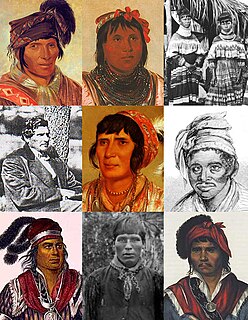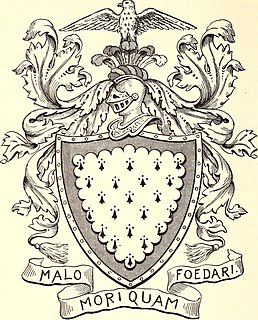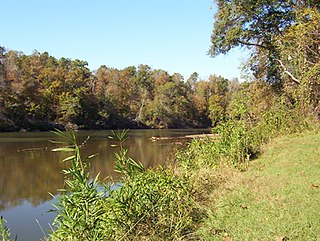Related Research Articles

The Tuscarora are a Native American tribe and First Nations band government of the Iroquoian-language family, with members today in New York, USA, and Ontario, Canada. They coalesced as a people around the Great Lakes, likely about the same time as the rise of the Five Nations of the historic Iroquois Confederacy, also Iroquoian-speaking and based then in present-day New York.

The Tuscarora War was fought in North Carolina from September 10, 1711 until February 11, 1715 between the Tuscarora people and their allies on one side and European American settlers, the Yamassee, and other allies on the other. This was considered the bloodiest colonial war in North Carolina. The Tuscarora signed a treaty with colonial officials in 1718 and settled on a reserved tract of land in Bertie County, North Carolina. The war incited further conflict on the part of the Tuscarora and led to changes in the slave trade of North and South Carolina.
The Waccamaw people are an indigenous people of the Southeastern Woodlands, who lived in villages along the Waccamaw River and Pee Dee River in North and South Carolina in the 18th century.

Indigenous peoples of the Southeastern Woodlands, Southeastern cultures, or Southeast Indians are an ethnographic classification for Native Americans who have traditionally inhabited the area now part of the Southeastern United States and the northeastern border of Mexico, that share common cultural traits. This classification is a part of the Eastern Woodlands. The concept of a southeastern cultural region was developed by anthropologists, beginning with Otis Mason and Frank Boas in 1887. The boundaries of the region are defined more by shared cultural traits than by geographic distinctions. Because the cultures gradually instead of abruptly shift into Plains, Prairie, or Northeastern Woodlands cultures, scholars do not always agree on the exact limits of the Southeastern Woodland culture region. Shawnee, Powhatan, Waco, Tawakoni, Tonkawa, Karankawa, Quapaw, and Mosopelea are usually seen as marginally southeastern and their traditional lands represent the borders of the cultural region.
The Winyaw were a Native American tribe living near Winyah Bay, Black River, and the lower course of the Pee Dee River in South Carolina. The Winyaw people disappeared as a distinct entity after 1720 and are thought to have merged with the Waccamaw.
The Meherrin Nation is one of seven state-recognized nations of Native Americans in North Carolina. They reside in rural northeastern North Carolina, near the river of the same name on the Virginia-North Carolina border. Historically the Iroquoian-speaking tribe had lived in the Piedmont of Virginia but moved south in the early 18th century under pressure of English colonists' encroachment on their territory.

The Pee Dee people, also Pedee and Peedee, are American Indians of the Southeast United States. Historically, their population has been concentrated in the Piedmont of present-day South Carolina. In the 17th and 18th centuries, English colonists named the Pee Dee River and the Pee Dee region of South Carolina for the tribe.
The Coree were a very small Native American tribe, who once occupied a coastal area south of the Neuse River in southeastern North Carolina in the area now covered by Carteret and Craven counties. Early 20th-century scholars were unsure of what language they spoke, but the coastal areas were mostly populated by Iroquois and Algonquian peoples.

The Cheraw people, also known as the Saraw or Saura, were a Siouan-speaking tribe of indigenous people of the Southeastern Woodlands, in the Piedmont area of North Carolina near the Sauratown Mountains, east of Pilot Mountain and north of the Yadkin River. They lived in villages near the Catawba River. Their first European and African contact was with the Hernando De Soto Expedition in 1540. The early explorer John Lawson included them in the larger eastern-Siouan confederacy, which he called "the Esaw Nation."
The Wateree were a Native American tribe in the interior of the present-day Carolinas. They probably belonged to the Siouan-Catawba language family. First encountered by the Spanish in 1567 in Western North Carolina, they migrated to the southeast and what developed as South Carolina by 1700, where English colonists noted them.
The Surruque people lived along the middle Atlantic coast of Florida during the 16th and 17th centuries. They may have spoken a dialect of the Timucua language, but were allied with the Ais. The Surruque became clients of the Spanish government in St. Augustine, but were not successfully brought into the Spanish mission system.

John Barnwell (1671–1724) was an Anglo Irishman who emigrated to the Province of South Carolina in 1701. He led an army against the Tuscarora in 1711–1712. Later he served the colony as an official in talks with England in forming the government. He also worked to revive the relationship between the colony and its former allies the Yamasee.
The Cusabo or Cosabo are a group of American Indian tribes who lived along the coast of the Atlantic Ocean in what is now South Carolina, approximately between present-day Charleston and south to the Savannah River, at the time of European colonization. English colonists often referred to them as one of the Settlement Indians of South Carolina, tribes who "settled" among the colonists.

The Nottoway are a Native American tribe in Virginia. Historically, the Nottoway spoke an Iroquoian language, Nottoway, and were related to other Iroquoian speakers.
King Yanabe Yalangway was the eractasswa (chief) of the Catawba Indian Nation, sometime around the 1740s. Not much is known about him other than the fact that he preceded King Hagler as chief. His training was evidently under "king" Whitmannetaughehee's leadership.
The Neche were a Native American tribe from eastern Texas.
The Nanatsoho were a Native American tribe that lived at the border of Arkansas, Oklahoma, and Texas.
The Cherokee people of the southeastern United States, and later Oklahoma and surrounding areas, have a long military history. Since European contact, Cherokee military activity has been documented in European records. Cherokee tribes and bands had a number of conflicts during the 18th century with European colonizing forces, primarily the English. The Eastern Band and Cherokees from the Indian Territory fought in the American Civil War, with bands allying with the Union or the Confederacy. Because many Cherokees allied with the Confederacy, the United States government required a new treaty with the nation after the war. Cherokees have also served in the United States military during the 20th and 21st centuries.
Francisco de Chicora was the baptismal name given to a Native American kidnapped in 1521, along with 70 others, from near the mouth of the Pee Dee River by Spanish explorer Francisco Gordillo and slave trader Pedro de Quexos, based in Santo Domingo and the first Europeans to reach the area. From analysis of the account by Peter Martyr, court chronicler, the ethnographer John R. Swanton believed that Chicora was from a Catawban group.

The Tallapoosas were a division of the Upper Creeks in the Muscogee Confederacy. Prior to Removal to Indian Territory, Tallapoosa lived along the Tallapoosa River in Alabama.
References
- Milanich, Jerald T. (2004). Handbook of North American Indians: Southeast. Washington, DC: Smithsonian Institution. pp. 229–237. ISBN 0-16-072300-0.
- Rudes, Blair A.; Thomas J. Blumer; J. Alan May (2004). Fogelson, Raymond D. (ed.). Handbook of North American Indians. Washington, DC: Smithsonian Institution. pp. 301–318. ISBN 0-16-072300-0.
- Swanton, John Reed (1952). The Indian Tribes of North America. Washington, DC: Smithsonian Institution (Reprinted by Genealogical Press). ISBN 9780806317304.